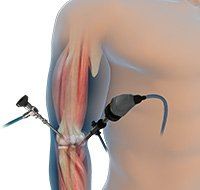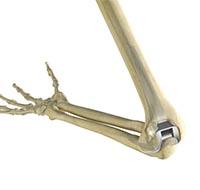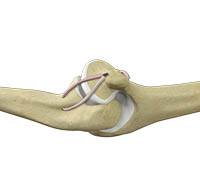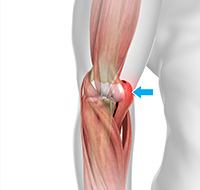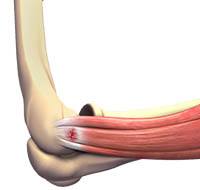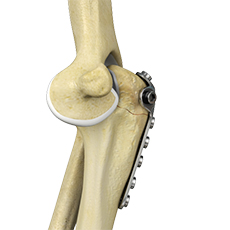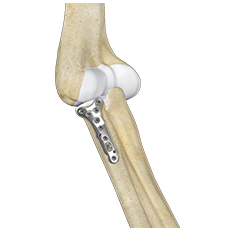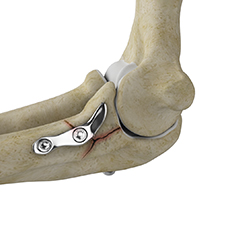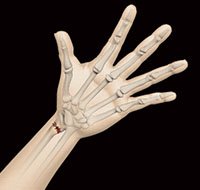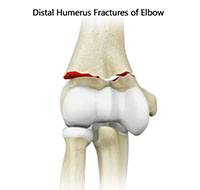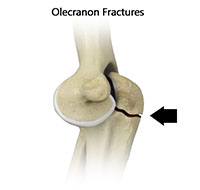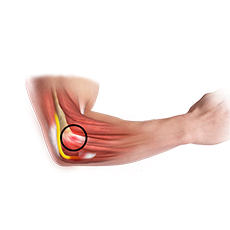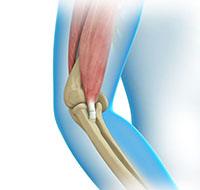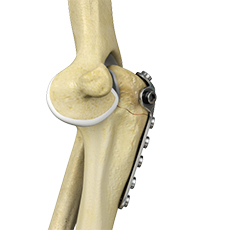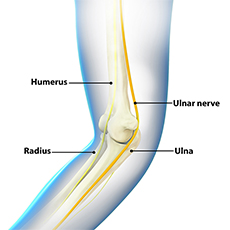Elbow Procedures
Elbow Arthroscopy
Elbow arthroscopy, also referred to as keyhole or minimally invasive surgery, is a surgical procedure that is performed through tiny incisions to evaluate and treat several elbow conditions.
Total Elbow Replacement
Elbow joint replacement, also referred to as total elbow arthroplasty, is an operative procedure to treat the symptoms of arthritis that have not responded to non-surgical treatments. The goal of elbow joint replacement surgery is to eliminate your pain and increase the mobility of your elbow joint.
Elbow Ligament Reconstruction
Ligament reconstruction is considered in patients with ligament rupture. Your surgeon will make an incision over the elbow. Care is taken to move muscles, tendons, and nerves out of the way. The donor's tendon is harvested from either the forearm or below the knee. Your surgeon drills holes into the bones of the upper arm and forearm, around the elbow joint.
Golfer's Elbow Surgery
Surgical intervention is necessary if you do not respond to conservative methods after about 6 months. Open surgery is usually performed to treat golfer's elbow although an arthroscopic technique may also be used.
Tennis Elbow Surgery
If conservative treatment options fail to resolve the condition and symptoms persist for 6 ‐ 12 months, your surgeon may recommend a surgical procedure to treat tennis elbow called lateral epicondyle release surgery. Surgery is considered a last resort and only 1 in 10 patients requires surgical intervention. The surgical success rate for relieving tennis elbow pain is 85‐95%. The goal of tennis elbow surgery is to remove the diseased tissue around the outer elbow, improve blood supply to the area, and alleviate your symptoms.
ORIF of the Humerus Fractures
A humerus fracture is a condition that occurs when there is a break in the humerus or upper arm bone that commonly occurs as a result of severe trauma. Fracture of the humerus can affect the movement and function of your arm as well as your work and activities of daily living. Humerus fractures are quite common and occur in individuals of all ages from children to the elderly.
Radial Head ORIF and Replacement
Open reduction and internal fixation (ORIF) of the radial head is a surgical technique employed for the treatment of a radial head fracture to restore normal anatomy and improve range of motion and function.
ORIF of the Coronoid Fractures
Coronoid fractures are a break in the coronoid process of the ulna due to trauma or injury. A coronoid fracture of the ulna is a complex intraarticular fracture that is difficult to expose due to complex surrounding anatomical structures. Fractures of the coronoid rarely occur in isolation and often occurs in association with elbow dislocations and play a significant role in elbow instability.
ORIF of Distal Radius Fracture
The forearm consists of two bones, the radius and ulna. The radius is the larger of the two forearm bones, and the region towards the wrist is called the distal end. A fracture or break in the distal end of the radius bone is known as a distal radius fracture.
ORIF of the Distal Humerus Fractures
A distal humerus fracture is a condition that occurs when there is a break in the lower end of the humerus bone that commonly occurs as a result of severe trauma. Fracture of the distal humerus can affect the movement and function of your arm as well as your work and activities of daily living. Distal humerus fractures are quite common and occur in individuals of all ages from children to the elderly.
ORIF of the Olecranon Fractures
Olecranon fractures are described as a break in the bony tip of the elbow that sticks out when you bend your arm. A fracture of the olecranon bone can be very painful and make motion of the elbow difficult or impossible. This kind of fracture is common and normally happens in isolation (with no other injuries involved).
Common Extensor Tendon Origin Repair
The common extensor tendon is a tough band of fibrous connective tissue that attaches to the lateral epicondyle of the humerus (long bone in the upper arm) at the elbow. Rupture or tear of the common extensor tendon is the most common acute tendon injury of the elbow. The most frequent pathology of the common extensor tendon is epicondylitis and is characterized by loss of normal tendon structure.
Elbow Tendon and Ligament Repair
Ligament reconstruction is considered to treat ligament rupture. Your surgeon will make an incision over the elbow. Care is taken to move muscles, tendons, and nerves out of the way. The donor's tendon is harvested from either the forearm or below the knee. Your surgeon drills holes into the bones of the upper arm and the forearm, around the elbow joint.
Elbow Fracture Reconstruction
Elbow fracture reconstruction is a surgical procedure employed to repair and restore the appearance and full function of a damaged elbow caused by severe trauma or injury. This may include repairing damaged structures or replacing missing or damaged structures with adjoining skin, muscles, ligaments, tendons, bones, or nerves to restore the appearance and function. This may also include bone fusion (arthrodesis) or replacement of a joint (arthroplasty) to mitigate pain.
Ulnar Nerve Transposition
The ulnar nerve is one of the 3 main nerves in the arm that travels down from the neck through a bony protuberance inside the elbow (medial epicondyle), under the muscles of the forearm and down the hand on the side of the palm, towards the little finger. The ulnar nerve helps in controlling most of the hand muscles which carry out fine movements as well as some bigger forearm muscles which help in making a strong grip.

